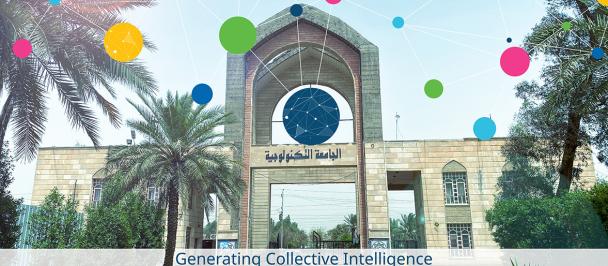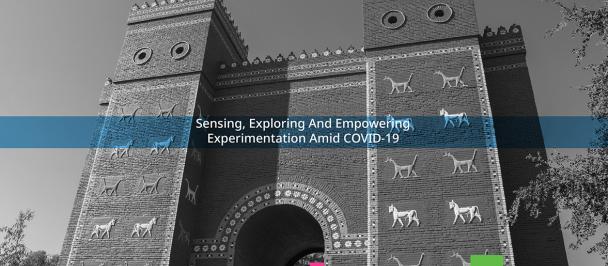We see opportunities during COVID-19 pandemic, we are not just daydreaming, we are learning to explore these opportunities and make them reality. This learning process enabled us, the UNDP Accelerator Lab in Iraq, to sense, explore, and lay the ground for experimentation around the digitalization of curriculum implementation, and upskilling within higher education.
Despite the COVID-19 Response, including lockdown and public health measures to ensure social distancing, Iraq has reported around 154,000 Coronavirus cases, witnessed an almost 29% budgetary deficit due to collapse of oil prices, and is forecasting an economic collapse by almost 9.7% accompanied by an increase in poverty by 40% due to lose of economic opportunities. With this in mind, the Accelerator Lab in Iraq is learning to map the new forces of economic opportunity. But, how can we equip our youth better for the changing labor market structure and most importantly how can we create added value for the economy?
We dig deeper into our unique learning process both in its component parts - including our own exploration methodologies, as well as learning how these methodologies can support us in ‘building back better’ in our communities, and how young Iraqis can co opt this process too!
Part 1: What do our exploration methodologies shed light on?
Our exploration methodologies and foresight framework teach us to take available data, analyze it and produce insights to guide our way. As a part of framing the challenge for youth and unemployment and defining the key issues and current conditions with the relevant stakeholders, the Lab held two workshops in December 2019 to perform systems mapping, draw the causality loop, and develop a hypothesis framework to narrow down the challenge of youth and unemployment. The product of the framing resulted in and focus specifically on “Tunnel-Vision Employment” within Iraqi youth. The analysis resulted in a specific focus on academia and considered it the main factor behind the limitation youth put on their career options and the existing gap between market required skills and the supply of skills by academia. In order to further analyze the issue, the UNDP Accelerator Lab in Iraq drew a causality loop for the current academic sector - a diagram that allows for visualizing how the different variables in the academic sector are interrelated. This process was done with six representatives from Iraqi ministries and nine representatives from the entrepreneurial ecosystem and it resulted into insights:
The sequence of the tunnel-vision of employment amongst academia, that drives the learning process in Iraq and hence affects students’ skills and knowledge, includes four main parts: curriculum implementation, teachers, universities, and students.
After drawing the causality loop, curriculum implementation seemed to be the critical point that drove all others, and is our base to equip youth with more skills to function in the job market.
The critical point for an intervention was identified. Now, our role as Heads of Explorations was to scan existing efforts to change, and qualify their implications for systematic impact; simply perform what is called “Mapping Signals of Change”. However, in the process of looking for emerging trends to break the status-quo and identify the factors that would break the causality loop, COVID-19 hit. Now it has become more relevant to map signals in this new reality, the reality of a pandemic and its multitude of impacts all over the world!
Part 2: How COVID-19 broke the causality loop of “Tunnel-Vision Employment” within the academic sector?
Our sensing and exploring work are crucial, but is now even more relevant in the fast-changing world of COVID-19. The use of data, mapping of stakeholders and weak signals, anticipating possible changes and ultimately treating the pandemic as an opportunity is important to reveal both the challenges and opportunities for youth and unemployment in Iraq. In order to zoom in on the effect of these sources of change and inform UNDP Iraq of the next steps of intervention, the Accelerator Lab undertook Mapping Signals of change to identify:
1. What would the new normal look like?
2. What are the surfacing needs in the academic sector in response to COVID-19?
3. How could these provide a window of opportunity to break the existing causality loop of ‘Tunnel-Vision Employment’?
The Accelerator Lab used both the usual research methods (online, articles, research, and the work of other organizations) as well as personalized meetings. The meeting process started by identifying the stakeholders to provide insights - including stakeholders from UNDP, development agencies, private sector, government institutions, local and international NGOs, entrepreneurs, innovation hubs, and research centers. The analysis of the research and discussion content led to the uncovering of four weak signals: emergence of e-learning, virtual capacity building modalities, online-shopping, and e-payment. All the signals directly and indirectly evolve around changes in the academic sector and the future structure of the labor market in Iraq. For now we will focus on the most prominent signals across all our research, e-learning.
In order to investigate further the effect of e-learning on the academic sector, especially the relationship between the curriculum implementation and e-learning, we will hypothesis:
“If we use e-learning to break the causality loop, then the universities change the curriculum implementation, thus improving the quality of education and the employability of graduates”
To validate the hypothesis activities, the Accelerator Lab initiated focus-groups discussion and observations. The results produced valuable information. First, both public and private learning institutions instructed all schools and universities to facilitate classes online using Google Classrooms, Zoom meetings, Free Conference Call (FCC), and other tools to substitute for in-class learning. Second, the local community, and specifically aspiring Iraqi youth, are catching up and providing e-learning solutions specific to Iraqis needs, like the Newton Platform, Najeh platform, and the My Journey with 6th Grade project.
From above, we can observe that the use of e-learning has led to a shift in curriculum implementation techniques for both teachers and students; teachers started giving lectures and using online methods as well as structuring their evaluation methods virtually. This is a temporary break in the causality loop, but this break needs to be further structured and institutionalized.
Part 3: From e-learning to blended learning, how these methodologies are supporting us in ‘building back better’ for our education system and future employment opportunities?
The e-learning signal is emerging, but it is a weak signal that only acquired such great attention due to the pandemic. Now the question is how can we sustain this break in the causality loop and aim to change the curriculum implementation guidance and process, while working towards institutionalizing it?
The good news is that the pandemic provides a tremendous window of opportunity to strengthen this signal. And, we have already started to see incoherent but strategic efforts to institutionalize change in curriculum implementation.
The UNDP Accelerator Lab held two searchlight events with the Ministry of Higher Education and Scientific Research (MoHESR) to further validate the hypothesis. The events shed light on efforts for change to the implementation of the curriculum within MoHESR and private universities. MoHESR started advocating for the enhanced professional development of Iraqi teachers in technological skills to further localize e-learning. Private universities with more resources also started investing in technological infrastructure in order to lay the ground for a long-term shift in teaching methods.
All these scattered efforts led to change in the implementation mechanism of the curriculum temporarily, but they also have aspects of a permanent change to blended-learning. Blended-learning includes the use of offline and online methods for teaching. This commitment towards the institutionalization of blended-learning was expressed vocally by the Head of Development and Human Resources Department at MoHESR “the ministry aims to move to blended learning in order to provide a way to overcome the sudden shocks that hit the consistency of the education process”.
This digitalization, and the alteration of the labor market structure, will shape the future of work in Iraq. Our research yields that in the long run if this change is institutionalized - considering the futures change wheel and quick response time - we might not witness a sharp decrease in unemployment, but rather a change in students’ behaviour and the structure of the job market. For students, it will provide more learning opportunities to the most vulnerable, increase the tendency toward learning the digital skills that are in high demand in the job market, and expand the depth and breadth of the Iraqi openness to the world. For the job market, this will lead to high demand for digital innovators, a technologically skilled workforce, software and graphic designers, and career counselors. But most importantly this will encourage professionals to develop their own set of skills without demanding permanent employment and shifting to more self-employment. For the overall market, all the weak signals, identified in Iraq during the COVID-19 pandemic, establish a case for movement towards digitalization, which should lead to more efficiency and economic value generation.
In this blog, the UNDP Accelerator Lab in Iraq investigated and explored the hypothesis to foresee before anyone else the importance of blended learning; the next phase will be experimenting the hypothesis and validating the hypothesis through paving the road for blended learning. Currently, MoHSER and UNDP are in the process of establishing a partnership to develop a roadmap for blended learning in Iraq.

 Locations
Locations




